Trees Birds Mammals Fish Amphibians Reptiles
Wild Algarve
Bookshop
Agaricus campestris L. - Field Mushroom
Phylum: Basidiomycota - Class: Agaricomycetes - Order: Agaricales - Family: Agaricaceae
Distribution - Taxonomic History - Etymology - Toxicity - Identification - Culinary Notes - Reference Sources
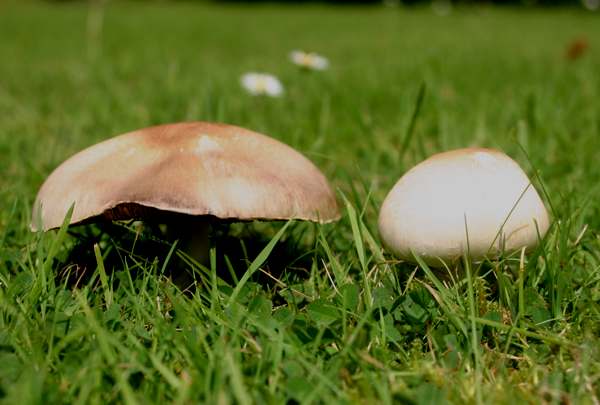
The Field Mushroom, Agaricus campestris, is the
most commonly eaten wild mushroom in Britain and Ireland. Meadows grazed
by sheep, cattle or horses sometimes produce vast quantities of these fungi of summer and early autumn... but not every year, unfortunately.
It is unwise to treat cap colour as a significant feature when identifying these kinds of mushrooms. Some Field Mushrooms are smooth and almost pure white while others are quite rough with dark-brown cap scales.
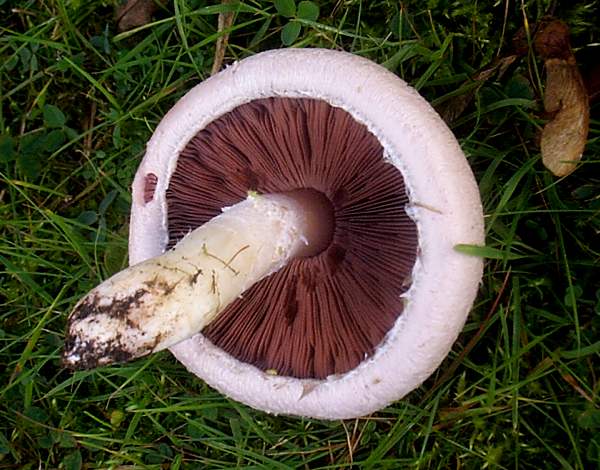
Distribution
Widespread and common in Britain and Ireland, Field Mushrooms have a truly world-wide distribution. They occurs throughout most of Europe, North Africa, Asia (including India, China and Japan), and in the USA, Canada and Australia.
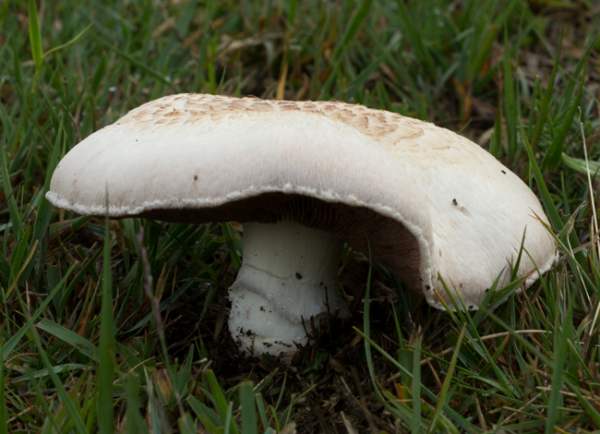
Taxonomic history
Originally described in 1753 by Carl Linnaeus and given the binomial scientific name Agaricus campestris, the Field Mushroom retains that scientific name. Two very rare (in Britain) varieties have since been defined, so that the nominate varietys is formally recorde as Agaricus campestris var. campestris L.
Synonyms of Agaricus campestris include Pratella campestris (L.) Gray, Psalliota campestris (L.) Quél., and Psalliota flocculosa Rea.
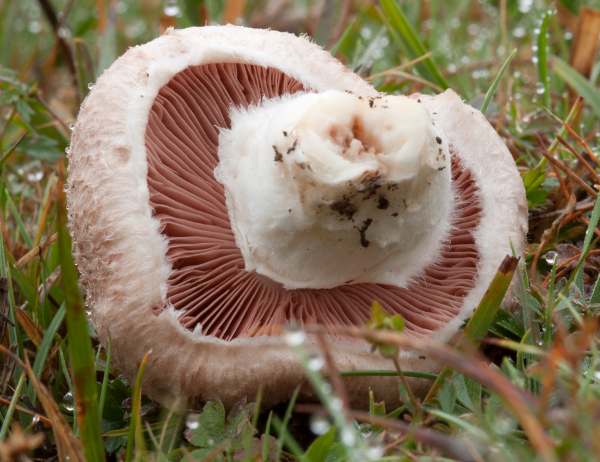
For a long time 'true mushrooms' that are now recorded as Agaricus species were given the generic name Psalliota, derived from a Greek word referring to their stem rings, and so in some older texts you may come across Psalliota campestris, a once popular synonym for Agaricus campestris, the Field Mushroom.
Etymology
The specific epithet campestris, chosen by Carl Linnaeus in 1753 and unchanged to this day, comes from the Latin word for a field.
In the USA this common edible fungus, which is in fact the 'type species' of the genus Agaricus, is more often referred to as the Meadow Mushroom. Gilled mushrooms are often referred to as 'agarics', and in the early days of fungal taxonomy most gilled mushrooms were simply included in one gigantic genus, Agaricus.
Toxicity
Provided they are properly cooked and eaten in moderation (not as a daily dish!) Field Mushrooms are wholesome and very tasty. It is unwise to gather any food from the grassy verges of busy roads, because the soil, vegetation and fungal fruitbodies from such places may be polluted by toxins emitted from exhausts or from oil spills.
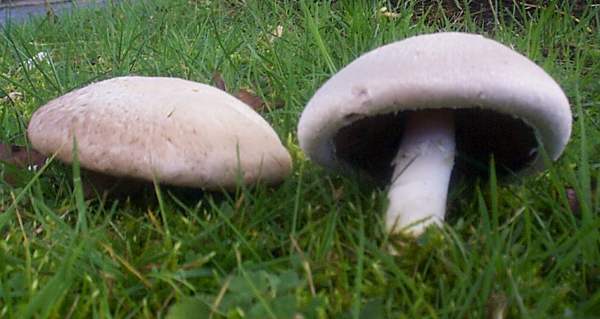
Field Mushrooms, which are very closely related to the familiar supermarket button mushrooms (Agaricus bisporus) are saprobic. Their mycelium feeds on dead vegetation in the soil - grass roots, for example. It is not uncommon to see Field Mushrooms growing in fairy rings, but more often they occur as singletons or apparently randomly scattered small groups. When my grandfather's fields were harvested by hand and the hay carried away by horse-drawn carts, the meadows grazed by cart horses would turn white in late summer as the Field Mushrooms fruited in vast quantities. Even sixty years ago it was not uncommon to be able to pick in half an hour as many mushrooms as one person could carry home.
Identification guide
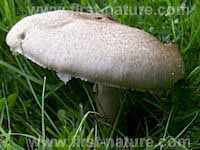 |
Cap
3 to 10cm in diameter, the caps of Field Mushrooms are creamy
white, sometimes developing small scales as they mature. Usually the
margin remains down-turned or slightly in-rolled even when the cap has
expanded fully.
The thick flesh is white, sometimes turning slightly pink when cut
but never staining yellow. |
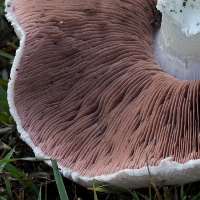 |
Gills
Deep pink at first, the free crowded gills
turn dark brown and eventually almost black as the fruitbody matures.
Old specimens may become infested by maggots, which enter the cap
flesh via the gills. Careful inspection is necessary, and it is
inadvisable to include very old specimens in collections intended for
food. |
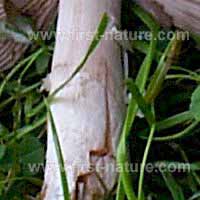 |
Stem
3 to 10cm tall and 1 to 2cm in diameter,
the white stem of Agaricus campestris is smooth above the single, delicate ring and somewhat
scaly below. It is more or less parallel and does not turn yellow when
cut.
The ring itself is ephemeral, and by the time the fruitbody is fully
developed there is rarely much evidence of a ring remaining. |
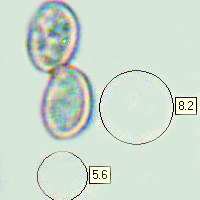 |
Spores
Ovoid, 6.5-9 x 4-6µm.
Spore print
Deep chocolate brown. |
Odour/taste |
Not distinctive. |
Habitat & Ecological role |
Saprobic, on soil among grass in pastures, playing
fields and parks. |
Season |
June to October. |
Similar species |
Agaricus bitorquis, the Pavement Mushroom, is very similar
but with a thin double ring; it favours dry, compacted places beside paths.
Agaricus arvensis, the Horse Mushroom, is usually somewhat larger than the Field Mushroom and, while initially having a similar white cap, at maturity it takes on a yellowish hue. |
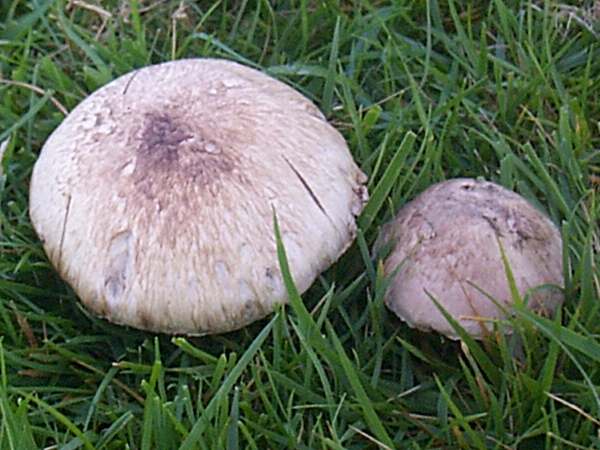
Culinary Notes
The Field Mushroom is a very good edible species and can be used in any recipe calling for cultivated (button) mushrooms. It is great in risotto dishes and omelettes, and it certainly has enough flavour to make tasty soups or sauces to be served with meat dishes. Try our Chicken Campestris; we think you will love it!
Reference Sources
Fascinated by Fungi, 2nd Edition, Pat O'Reilly 2016, reprinted by Coch-y-bonddu Books in 2022.
The genus Agaricus in Britain, 3rd Edition, self-published, Geoffrey Kibby 2011
Funga Nordica: 2nd edition 2012. Edited by Knudsen, H. & Vesterholt, J. ISBN 9788798396130
BMS List of English Names for Fungi
Dictionary of the Fungi; Paul M. Kirk, Paul F. Cannon, David W. Minter and J. A. Stalpers; CABI, 2008
Taxonomic history and synonym information on these pages is drawn from many sources but in particular from the British Mycological Society's GB Checklist of Fungi.
Acknowledgements
This page includes pictures kindly contributed by David Kelly.
Top of page...
Fascinated by Fungi. Back by popular demand, Pat O'Reilly's best-selling 450-page hardback book is available now. The latest second edition was republished with a sparkling new cover design in September 2022 by Coch-y-Bonddu Books. Full details and copies are available from the publisher's online bookshop...